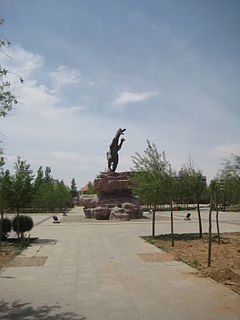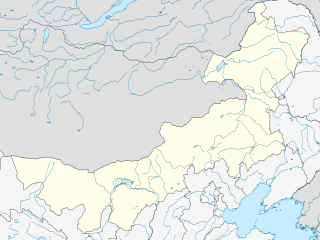
The Mongolian languageMoŋɣol kele; in Mongolian Cyrillic: монгол хэл, mongol khel) is the official language of Mongolia and both the most widely-spoken and best-known member of the Mongolic language family. The number of speakers across all its dialects may be 5.2 million, including the vast majority of the residents of Mongolia and many of the Mongolian residents of the Inner Mongolia Autonomous Region. In Mongolia, the Khalkha dialect, written in Cyrillic, is predominant, while in Inner Mongolia, the language is dialectally more diverse and is written in the traditional Mongolian script. In the discussion of grammar to follow, the variety of Mongolian treated is Standard Khalkha Mongolian, but much of what is to be said is also valid for vernacular (spoken) Khalkha and for other Mongolian dialects, especially Chakhar.

The Mongolic languages are a group of languages spoken in East-Central Asia, mostly in Mongolia and surrounding areas plus in Kalmykia and Buryatia. The best-known member of this language family, Mongolian, is the primary language of most of the residents of Mongolia and the Mongolian residents of Inner Mongolia, with an estimated 5.7+ million speakers.

Dzhokhar Musayevich Dudayev was a Soviet Air Force general and Chechen leader, the first President of the Chechen Republic of Ichkeria, a breakaway region in the North Caucasus, from 1991 to his death 1996.

Chaharshanbe Suri is an Iranian festival celebrated on the eve of the last Wednesday before Nowruz.
Ahmad ibn Umar ibn Alī, known as Nizamī-i Arūzī-i Samarqandī and also Arudi, was a Persian poet and prose writer who flourished between 1110 and 1161 AD. He is particularly famous for his Chahar Maghaleh, his only work to fully survive. While living in Samarqand, Abu’l-Rajaʾ Ahmad b. ʿAbd-Al-Ṣamad, a dehqan in Transoxiana, told Nezami of how the poet Rudaki was given compensation for his poem extolling the virtues of Samanid Amir Nasr b. Ahmad.
The Khalkha dialect is a dialect of Mongolian widely spoken in Mongolia and according to some classifications includes such Southern Mongolian varieties such as Shiliin gol, Ulaanchab and Sönid. As it was the basis for the Cyrillic orthography of Mongolian, it is de facto the national language of Mongolia. The name of the dialect is related to the name of the Khalkha Mongols and the Khalkha river.

Xilingol, Xilin Gol, Shiliin Gol or Xilinguole Aimag/League is one of 12 leagues of Inner Mongolia. The seat is Xilinhot, while the area is 202,580 km2 (78,220 sq mi). The league's economy is based on mining and agriculture.

Banaripara is an Upazila of Barisal District in the Division of Barisal in southern-central Bangladesh.
Ligdan Khutugtu Khan was the last khan of the Northern Yuan dynasty based in Mongolia as well as the last in the Borjigin clan of Mongol Khans who ruled the Mongols from Chakhar. His unpopular reign generated violent opposition due to his harsh restrictions over the Mongols. His alliance with Ming dynasty of China, sponsorship of Tibetan Buddhism in Chakhar and reorganization of Mongolian political divisions were ineffective when the Qing dynasty became the major power in East Asia.

The classical or traditional Mongolian script, also known as Hudum Mongol bichig, was the first writing system created specifically for the Mongolian language, and was the most successful until the introduction of Cyrillic in 1946. Derived from the Old Uyghur alphabet, Mongolian is a true alphabet, with separate letters for consonants and vowels. The Mongolian script has been adapted to write languages such as Oirat and Manchu. Alphabets based on this classical vertical script are used in Inner Mongolia and other parts of China to this day to write Mongolian, Xibe and experimentally, Evenki.
Chahar or Chakhar may refer to:
The Üzemchin, also written Ujumchin, Ujumucin or Ujimqin, are a subgroup of Mongols in eastern Mongolia and Inner Mongolia. They settle mainly in Sergelen, Bayantu'men, Choibalsan city of the Dornod Province and in Xilin Gol League of the Inner Mongolia. In Mongolia, Some Üzemchins migrated there from Xilin Gol immediately after China was freed from the Japanese in 1945.

Çartəpə is the azerbaijan village and municipality in the Quba Rayon of Azerbaijan. It has a population of 706.
The Chakhar dialect is a variety of Mongolian spoken in the central region of Inner Mongolia. It is phonologically close to Khalkha and is the basis for the standard pronunciation of Mongolian in Inner Mongolia.
Southern Mongolian or Inner Mongolian is a proposed major dialect group within the taxonomy of the Mongolian language. It is assumed by most Inner Mongolian linguists and would be on the same level as the other three major dialect groups Khalkha, Buryat, Oirat. Southern Mongolian would consist of the dialects Chakhar, Ordos, Baarin, Khorchin, Kharchin and (possibly) Alasha that originated from Oirat. The varieties spoken in Xilin Gol which form a major dialect of their own right and are close to Khalkha are classified as belonging to Chakhar in this approach. Because Southern Mongolian would consist of all non-Buryat Mongolian varieties spoken in Inner Mongolia, this classification has been argued against by several linguists who hold that there is a dialect continuum between Khalkha and the Southern Mongolian varieties that rather favours grouping Chakhar, Ordos and Khalkha on the one hand and Khorchin and Kharchin on the other hand, or at least that "Mongolian proper" is an immediate member of Mongolian/Mongolic. On the other hand, the argument that Southern Mongolian is distinct is based on considerations such as the following:

Abag Banner is a county of Inner Mongolia, People's Republic of China. It is under the administration of Xilin Gol League. Abag Mongols live here. The local dialect has variously been classified as Chakhar or Khalkha.

Chakhar Chamani is a village in Arshaq-e Gharbi Rural District, Moradlu District, Meshgin Shahr County, Ardabil Province, Iran. At the 2006 census, its population was 192, in 48 families.

Batar Chakhar is a village in Mahur Rural District, Mahvarmilani District, Mamasani County, Fars Province, Iran. At the 2006 census, its existence was noted, but its population was not reported.
Mazraeh-ye Pater Chakhar is a village in Bakesh-e Do Rural District, in the Central District of Mamasani County, Fars Province, Iran. At the 2006 census, its population was 20, in 5 families.












